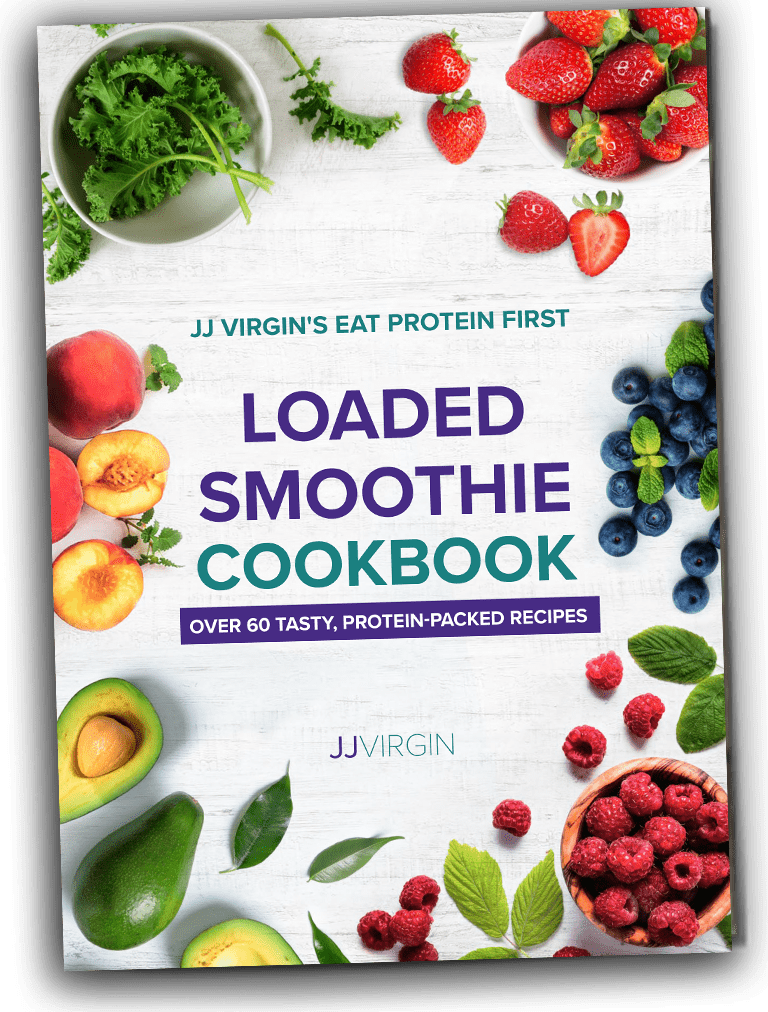Don’t shoot the messenger: while plant-based diets carry some benefits, they’re far from the most efficient way to get protein. Too often, I see vegans and vegetarians overdoing fat or carbs, crowding protein out of the picture.
Protein-based animal foods, including grass-fed beef and wild-caught seafood, are far superior to plant foods. Why? They provide all nine essential amino acids, for one. We call them “essential” because your body can’t make them, so you’ve got to get them from food. Plant foods, on the other hand, are low or deficient in one or more essential amino acids.
Your body also digests and absorbs animal protein better. Meat contains more protein per ounce compared to plant foods. A 6-ounce chicken breast contains about 32 grams of protein. You’d have to eat about 15 cups of broccoli to get that amount! What’s more, higher bioavailability in animal foods means you can utilize more of that protein.
To meet their protein quota, vegans and vegetarians often rely on processed foods and fake-meat products, which contain problematic ingredients like added sugar, preservatives, soy, and gluten. As a result, they’re more prone to develop food intolerances compared to omnivores.
After working with vegans and vegetarians for decades, I’ve identified four problem staple foods that create havoc when you repeatedly eat them. You can design an intelligent, plant-based diet, but it requires work and vigilance.
What Causes Food Intolerance?
Food intolerances occur when you repeatedly eat the same foods until your body reacts to or becomes sensitive to them. When you overwhelm your system with these foods, they eventually activate what we call an immunoglobulin G (IgG) response.
Learn more about food intolerances and why they occur in this blog.
Unlike food allergies, which come on quickly and dramatically, the reaction of a food intolerance is more subtle. IgG responses are chronic, low-grade, and they develop over time.
Because their effects aren’t always obvious, you may not connect symptoms like fatigue or cramping in your legs with an offending food you ate a few hours (or days) ago. These are delayed reactions that you’ve developed over time.
This delayed immune response can contribute to a deadly low-grade inflammation called chronic inflammation. Insulin resistance, digestive issues, and leaky gut are all repercussions of food sensitivities that are left unchecked.
Why Are Vegans and Vegetarians More Prone to Food Intolerance?
Except for eggs (which I’ll discuss shortly), few animal foods rarely create IgG responses. The most common reactions occur from foods like wheat, dairy, and soy—foods that vegans and vegetarians tend to rely on to replace meat and keep up their protein intake.
Protein is an essential nutrient that plays a crucial role in many of the body’s processes, which is why I emphasize prioritizing it in your meals and loaded smoothies. These processes include:
- Building and repairing tissues like muscles, skin, and bones.
- Maintaining a healthy immune system.
- Regulating metabolic processes, such as producing hormones, enzymes, and other important molecules.
- Promoting satiety, meaning you stay fuller longer after eating.3
Unfortunately, when you’re constantly bombarding your gut with problem foods, your body can’t get rid of those immune complexes.
Because eating a plant-based diet offers you less protein variety, it puts you at a higher risk for developing sensitivities. Unfortunately, many aren’t aware of the connection here because the symptoms are often delayed for a couple of days.
Vegan and Vegetarian Staple Foods That Cause Problems
With that lack of variety, vegans and vegetarians over-rely on the same problem foods repeatedly as their primary protein source. I’ve found that they often reach for four staple foods that can create problems: soy, gluten, dairy, and eggs.
Let’s look at each of these more closely.
Soy
Soy is cleverly positioned as an ideal source of protein for vegetarians and vegans. Popular soy-based staples include tofu, tempeh, soy milk, and soy protein powders.
When you have a soy protein shake for breakfast (with soymilk, of course), soy-based burgers for lunch, and a tofu stir-fry for dinner, you’re bombarding your system with soy all day long.
For those who are sensitive, eating soy at even one meal a day can set you up for food intolerances and other potential health risks, including:
- Thyroid function: Animal studies show that soy may interfere with the balance of thyroid hormones.4
- Hormone imbalances: Some research suggests that soy may disrupt endocrine function.5
- GMO concerns: Many soy crops are genetically modified (GMO). To learn more about why GMOS are harmful, I recommend Jeffrey Smith’s book Seeds of Deception.
You might wonder why it’s such an issue if people in Asia have been eating soy for ages. The American food system’s soy (and how we eat it in the US) is a much different beast.
I lived in Japan, and I witnessed folks having a little bit of tempeh or miso soup with their meal. They weren’t making soy a primary protein source, and they weren’t relying on “frankenfoods” like soy dogs and soy burgers for every meal, either.
Learn 5 reasons why there’s no joy in soy in this blog.
Eggs
Egg sensitivities are very common among vegetarians. I often see vegetarians eat hard-boiled eggs for breakfast, a mid-morning muffin made with egg, and then an omelet for dinner.
Over time, egg sensitivity can contribute to symptoms like headache, fatigue, joint pain, cramps, bloating, weight gain, and cravings.
While the primary protein in eggs (called albumin) creates most of these reactions, some people have an extreme sensitivity to the corn or soy typically offered to factory-farmed chickens. In those cases, choosing pasture-raised, organic eggs can eliminate symptoms, but you’ll still want to be aware of other reactions the albumin can cause.
Whatever your situation, you don’t want to make eggs a regular protein staple. Be aware that sneak into a lot of places. Omelets, quiches, and other breakfast foods are obvious, but eggs are also baked into pastries, pancakes, breads, and other conspicuous places.
Eggs are often hidden in soups (matzo ball soup, for instance), crepes, zucchini fritters (they sound so healthy!), stuffing, noodles, and other vegetarian-friendly dishes. You may even find eggs whipped into your drink at a fancy cocktail bar (double check any drink named with “fizz” or “sour”).
Gluten
Seitan is a popular plant-based food that provides the texture and flavor of meat for vegans and vegetarians. Hot dogs, burgers, and all sorts of other meat-based delights can be created from this popular meat substitute.
Unfortunately, seitan comes from wheat gluten. When you reach for seitan and other types of gluten regularly, you’re creating, or exacerbating, food intolerances. Studies show that when you go gluten-free, you reduce your risk of insulin resistance, calm inflammation, and reach your goal weight more easily.6
But gluten “hides” in much more than just seitan. Many people are consuming gluten in forms that they may not realize are gluten. Among its many disguises include:
- Wheat: durum, einkorn, emmer, farina, kamut, semolina, spelt
- Barley: malt (flavoring, extract, syrup, or vinegar)
- Rye: flour, kernel, bran
- Triticale (a cross between wheat and rye)
- Oats (naturally gluten-free, but may be contaminated with gluten during processing)
- Ingredients that contain the words “hydrolyzed” or “proteins”: these terms are often used to describe processed forms of wheat gluten
Many folks are pummeling their systems with gluten all day. They may have a bagel for breakfast, a sandwich on whole-wheat bread for lunch, pasta for dinner, polished off with a beer. We don’t recognize it coming in so many different forms, inadvertently giving people food sensitivities along the way.
The Food and Drug Administration (FDA) now requires that foods containing wheat, barley, or rye be clearly labeled on the ingredient list. However, the FDA does not require a separate gluten warning on food labels. If a food product is labeled as “gluten-free,” it may still contain very small amounts of gluten considered to be safe for individuals with celiac disease or gluten intolerance.
Personally, I find that 90% of the people I pull off gluten feel better without it. (I’m convinced the other 10% didn’t really get it all out, whether they followed the “everything in moderation” myth or got duped by sneaky sources.)
Gluten intolerance symptoms are like the symptoms of egg sensitivity: weight gain, digestive upset, headaches, joint pain, anxiety, depression, and especially leaky gut.
Dairy
Cow’s milk is another big offender. I see vegetarians eating cereal with milk for breakfast, snacking on yogurt, and adding cheese to their salads. Yes, dairy provides some protein, but at a potential cost.
Repeatedly consuming dairy in its many forms contributes to food intolerances, creating leaky gut, inflammation, immune reactions, and numerous symptoms like weight loss resistance.
Skin problems are one of the biggest reactions to dairy. One systematic review of children, adolescents, and young adults ages 7–30 concluded that any kind of dairy—including milk, yogurt, and cheese—could increase acne.7
Dairy intolerance symptoms can also show up as other skin conditions (including eczema, rosacea, and dermatitis), digestive issues, joint pain, fatigue, and autoimmune flare-ups.
Learn more about why so much of what you’ve been told about dairy is wrong.
Nutrient Deficiencies
Not getting enough nutrients can exacerbate the problems that these four foods create. Many plant-based diets are not well executed and rely on a lot of processed foods and have little variety. A vegetarian or vegan diet like this is lower in certain key nutrients, including vitamin B12 and omega-3 fatty acids, which can increase the risk of food intolerances.
Vitamin B12 is critical for nerve function, red blood cell formation, supporting the trillions of bacteria that inhabit your gut, and much more. Because only animal foods contain vitamin B12, vegetarians and especially vegans have a higher risk of deficiency. Researchers strongly recommend that people who avoid animal foods supplement with vitamin B12.8 If you’re a vegan and relying on these problematic foods, you’re doing a double whammy on your gut being deficient in vitamin B12.
Omega– 3 fatty acids are also critical for reducing inflammation and may help lower the risk of heart disease, cancer, and other chronic diseases.8
Studies show that intakes of the long-chain fatty acids EPA and DHA—which you can find in wild-caught seafood and grass-fed beef – are low in vegetarians and virtually absent in vegans.9
To compensate, you’ll want to include plant sources of alpha-linolenic acid (ALA), a plant-based omega-3 fatty acid. Flax and chia seeds are awesome sources of ALA, so toss them into loaded smoothies. Make ALA-rich walnuts your primary nut source, too.
Theoretically, your body can convert ALA to EPA and DHA fatty acids, but the process is not efficient. Therefore, you might want to supplement with an algae-derived DHA supplement to get those critical fatty acids. Learn more about omega-3s and why you need them in this blog.
How To Build a JJ-Approved, Protein-First Plant-Based Plate
Being a vegetarian or vegan does not automatically make you more prone to food intolerance. Rather, exposing your body to the same foods over and over coupled with a lack of variety creates the problem over time. If you choose to stick with a plant-based diet, I’ve got you covered!
With every meal, I want you to eat by the plate. That includes:
- 30-50 grams of protein
- 2-4 fat servings (every serving is about 100 calories)
- At least 2 non-starchy veggies
- 0-1 slow low carbs (every serving is about 100 calories)
Loaded smoothies are my favorite way to meet your mark. You’ll find lots of delicious recipes here (click on the Shakes & Smoothies tab to see the most popular in my community).
I’ve got plenty of plant-based recipes over there, too. Here are three recipes to get you started:
Because I want to support you every way possible if you choose a plant-based diet, you’ll find these three blogs incredibly helpful:
- This blog provides everything you need to eat plant-based and avoid food intolerance.
- Read about 7 ways to eat healthy as a vegan or vegetarian here.
- Getting 100 grams of plant-based protein is simple once you get the hang of it! In this blog, I describe the best protein sources for vegetarians and vegans as well as what a sample day might look like.
A Simple, Effective Way to Break Free of Food Intolerance
I’ve seen amazing things happen when people address food intolerance. One of my most dramatic case studies was a vegetarian client who was overweight and miserable, with symptoms ranging from joint pain to headaches and fatigue. By identifying and removing the foods that were keeping her unhealthy, she lost over 40 pounds and felt better than she had in decades!
In The Virgin Diet, I show you how dropping seven Hi-FI foods for just three weeks can create dramatic results. People are surprised how much better they look and feel when they eliminate these foods and then evaluate if they help or hurt their body.
That persistent runny nose disappears. They no longer run to the bathroom after every meal or suffer gas and bloating. Chronic issues like acne and other skin problems clear up. And, of course, they’re finally able to banish the last 10 pounds they’ve struggled with for ages, despite doing everything “right.”
Eating the right foods for you can work wonders even beyond weight loss—it’s the soothing medicine that increases energy, brightens your appearance, evens out hormones, detoxifies your system, balances blood sugar, reduces inflammation, and slows down the aging process.
The views in this blog by JJ Virgin should never be used as a substitute for professional medical advice. Please work with a healthcare practitioner concerning any medical problem or concern. The information here is not intended to diagnose, treat, or prevent any disease or condition. Statements contained here have not been evaluated by the Food and Drug Administration.
*These statements have not been evaluated by the Food and Drug Administration. This product is not intended to diagnose, treat, cure, or prevent any disease.
References:
- Melina V, Craig W, Levin S. Position of the Academy of Nutrition and Dietetics: Vegetarian Diets. J Acad Nutr Diet. 2016 Dec;116(12):1970-1980. doi: 10.1016/j.jand.2016.09.025. PMID: 27886704.
- Anderson JW, Baird P, Davis RH Jr, Ferreri S, Knudtson M, Koraym A, Waters V, Williams CL. Health benefits of dietary fiber. Nutr Rev. 2009 Apr;67(4):188-205. doi: 10.1111/j.1753-4887.2009.00189.x. PMID: 19335713.
- Noakes M. The role of protein in weight management. Asia Pac J Clin Nutr. 2008;17 Suppl 1:169-71. PMID: 18296329.
- Šošić-Jurjević B, Filipović B, Wirth EK, Živanović J, Radulović N, Janković S, Milošević V, Köhrle J. Soy isoflavones interfere with thyroid hormone homeostasis in orchidectomized middle-aged rats. Toxicol Appl Pharmacol. 2014 Jul 15;278(2):124-34. doi: 10.1016/j.taap.2014.04.018. Epub 2014 Apr 29. PMID: 24793811.
- Bar-El DS, Reifen R. Soy as an endocrine disruptor: cause for caution? J Pediatr Endocrinol Metab. 2010 Sep;23(9):855-61. doi: 10.1515/jpem.2010.138. PMID: 21175082.
- Soares FL, de Oliveira Matoso R, Teixeira LG, Menezes Z, Pereira SS, Alves AC, Batista NV, de Faria AM, Cara DC, Ferreira AV, Alvarez-Leite JI. Gluten-free diet reduces adiposity, inflammation and insulin resistance associated with the induction of PPAR-alpha and PPAR-gamma expression. J Nutr Biochem. 2013 Jun;24(6):1105-11. doi: 10.1016/j.jnutbio.2012.08.009. Epub 2012 Dec 17. PMID: 23253599.
- Juhl CR, Bergholdt HKM, Miller IM, Jemec GBE, Kanters JK, Ellervik C. Dairy Intake and Acne Vulgaris: A Systematic Review and Meta-Analysis of 78,529 Children, Adolescents, and Young Adults. Nutrients. 2018 Aug 9;10(8):1049. doi: 10.3390/nu10081049. PMID: 30096883; PMCID: PMC6115795.
- Pawlak R, Lester SE, Babatunde T. The prevalence of cobalamin deficiency among vegetarians assessed by serum vitamin B12: a review of literature. Eur J Clin Nutr. 2014 May;68(5):541-8. doi: 10.1038/ejcn.2014.46. Epub 2014 Mar 26. Erratum in: Eur J Clin Nutr. 2016 Jul;70(7):866. PMID: 24667752.
- Gammone MA, Riccioni G, Parrinello G, D’Orazio N. Omega-3 Polyunsaturated Fatty Acids: Benefits and Endpoints in Sport. Nutrients. 2018 Dec 27;11(1):46. doi: 10.3390/nu11010046. PMID: 30591639; PMCID: PMC6357022. Saunders AV, Davis BC, Garg ML. Omega-3 polyunsaturated fatty acids and vegetarian diets. Med J Aust. 2013 Aug 19;199(S4):S22-6. doi: 10.5694/mja11.11507. PMID: 25369925.






